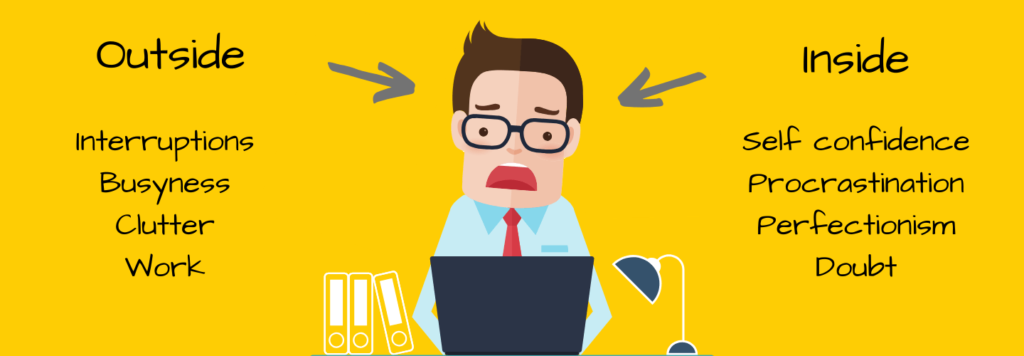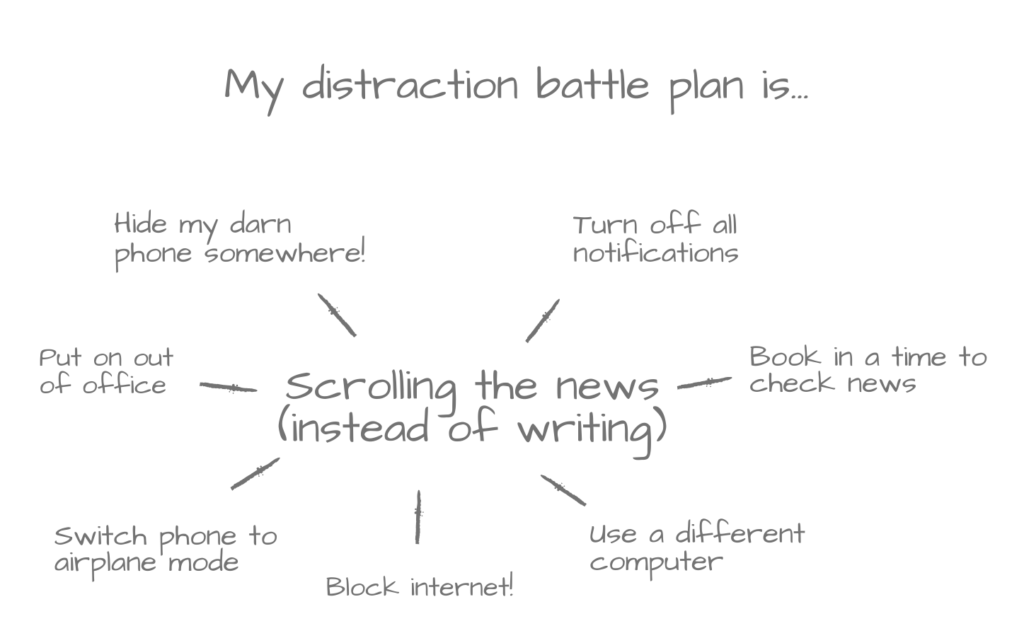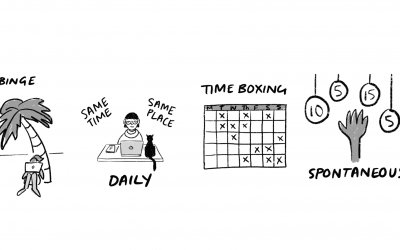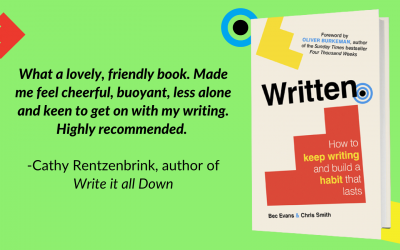If you’re safe and well, lockdown might seem like the perfect opportunity to write – all that time you never had – but in reality, keeping your focus can be tough. There are new interruptions and we get distracted by anxious thoughts. If you want to write there are some simple techniques that can help.
First thing’s first, if you’re unable to write, if you have additional responsibilities to yourself, family or friends, stop worrying. Give yourself a break and attend to what matters most in your life. Too many writers spend too long feeling guilty about not writing – now is not the time to beat yourself up.
Saying that, we work with writers every day and we know many want to write – out of necessity, or because it can bring a sense of normality in testing times – but they are finding it hard to stay focused. And who can blame them…
The way to cope with anxious thoughts or distractions isn’t to fight them or ignore them, but to understand how to respond to them. You can’t always control how you get distracted, instead there are steps you can take to feel more in control of how you respond when they do occur.
If you want to write, you can minimise the impact your distractions have if you’re prepared. With this in mind, here are five ways that can help you keep your focus in turbulent times:
1. Keep a distraction diary
When you don’t know how you get distracted, or where your interruptions come from, you’ll struggle to manage them. It’s time to take control. The first step is to note down your distractions as they occur. Think of it as a distraction diary.
Your distractions will have multiple forms and some will be more disrupting than others. Track the distractions you face from both the inside and from the outside.
“The way to cope with distractions isn’t to fight them, or ignore them, but to understand how to respond to them.”
For example, you might notice internal distractions like anxious thoughts, procrastination or self-doubt. You might also notice experiencing external distractions like your phone, email, the news. In addition, many writers will have family and community responsibilities at this time – commitments that deserve your full and undivided attention.
Observe, the distractions you experience, note down and don’t judge. Don’t dwell on these distractions or feel frustrated by them. Accept that they happen and record them as they occur, as a scientist would make observations in a lab.

>> Read more: Beat distraction: writing productivity tactics to try when you can’t concentrate
2. Practice obstacle thinking (and prepare a battle plan)
Now you know more about the nature of your distractions you’re already better prepared to avoid them. The next stage is to visualise what action you’ll take when you meet these distractions and obstacles in your day.
Thinking about what gets in the way of the writing you might want to do – your obstacles – can feel quite negative. People often prefer to focus on what they can achieve rather than what stops them. But when you think about the likely blocks and barriers ahead, you’re better placed to navigate them when you meet them.
Now you have your diary of distractions, obstacles and blocks, brainstorm the practical steps you can take to manage them when they occur.
For example, let’s say you’ve noticed that your writing gets impacted (and your anxiety increases) when you get news notifications on your phone. Brainstorm as many preventative measures as you can – these can be fun! Get creative and pick the solutions that are most practical and easy to implement for you.
Could you:
- Leave your phone somewhere else, or even hide it?
- Turn off notifications or turn on airplane mode?
- Switch it off entirely?
- Find alternatives to using your phone for everyday tasks, (hello egg timer)?
- Reserve your scrolling time for a specific time of the day?
- Block the internet entirely?!

3. Get a ‘when-then’ plan
Developing a preventative battle plan is a great step forward but now, you need to embed that behaviour so it becomes more routine-like and everyday. You need a simple strategy and you can get this by implementing a ‘when-then’ plan.
A ‘when-then’ plan is a way to trigger your brain into action, so one activity gets fused to another. It’s an approach rooted in neuroscience and it’s used to help people adopt new positive habits.
It’s a formulation you can use to move round your distractions as they occur. For example:
- When I write, then I’ll leave my phone in another room.
- When my writing time gets co-opted in the morning, then I’ll write for 30 minutes in the evening.
- When I feel unfocused and anxious, then I’ll take a breather for 15 minutes.
The key to ‘when-then’ planning is clarity. Make the action you will take unambiguous so it becomes a simple rule to follow.
>> Read more: 8 types of negative thinking that hold you back as a writer and how to overcome them
4. Use constraints to keep your focus
When you’re in an unfamiliar environment or feel lacking in structure it’s easy to become distracted and derailed from your writing.
One way to keep focused is to use constraints of some kind. This is an approach you can incorporate into your when-then planning. Writing constraints work because they apply a little pressure, focus your attention and give you boundaries.
“If you want to write, you can minimise the impact your distractions have if you’re prepared.”
One classic way to add discipline into your day is to use the Pomodoro technique:
- Set a timer for 25 minutes
- Write
- Take a five-minute break (do something unrelated to writing)
- Repeat as many times as you can
The Pomodoro technique works because it feels achievable, because it gives you structure and because it introduces a sense of urgency into your writing process – and the break acts as an incentive as you have something to look forward to.
Another constraint could be to write fewer words or for less time. For example, aim to write one paragraph per day then stop. Write for 30 minutes a day and no more. Many writers set the bar too high. It’s far better to write a few words each day than to fail to go big.
5. Accept and ‘park’ anxious thoughts
Not all of your distractions will be external. Many will be internal. At this time, your anxious thoughts might spiral – and that’s perfectly normal. In general, the concerns you have are either practical or hypothetical in nature:
- Practical worries are things you can take some kind of action to resolve now,
- Hypothetical worries are of the gnawing ‘what if…?’ variety that are legitimate and understandable, but stressful because they leave you feeling powerless.
If some of the distractions you’ve noticed and noted down in your diary are hypothetical – What if X happens? How will I cope if Y occurs – try reserving 20 minutes in your day as your ‘writing worry time’.
When your worry time arrives, set a timer, go through your worries one by one and ask yourself what practical action you can take to address that worry. If you can take a practical action – do it. If you can’t, park it or cross it off the list.
The worries you have should be acknowledged. They are legitimate. ‘Parking’ them doesn’t mean glibly dismissing them or pretending they’re not serious. This approach is about managing how you respond to them so they don’t derail you in the present.
>> Read more: How to stop procrastinating for good: a guide for writers
Keep your focus – but don’t feel guilty if you can’t write…
Too many writers spend too long feeling guilty that they should be writing. If your distractions and commitments are such that you can’t write – accept this and don’t feel bad. These are troubling times – your writing will always be there.
But if you want to write, try some of these strategies and think about how you respond to your distractions – because writing can bring much-needed sanity and control in an unpredictable world.




